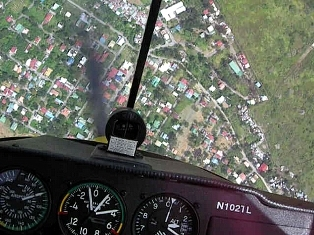D-Day, 6th of June, 1944. The Allies invaded Normandy and started the 11-month drive to liberate Europe from Nazi Germany. Just after midnight on June 6, thousands of paratroopers dropped behind enemy lines to secure the flanks of the invasion beaches.

Over 45 years ago I read Cornelius Ryan’s The Longest Day and saw the movie. John Wayne’s airborne landing at Sainte-Mère-Église captivated me and fired up my young imagination.

Like every boy, I played with plastic toy soldiers. I collected eight good soldiers. I used toy cowboys and pirates for the enemy. I learned to shoot the enemy with rubber bands. They would be hiding behind chair legs or dominos and, BANG! My rubber bands sent them flying. I became a dead-shot rubber band sniper. I provided my own sound effects, which, unknown to me, resonated through our house. “Pow-pow-kapow, KABOOM!”
There was a day that I especially trained my soldiers for.
Every year on the night of June 5, I took my brave soldiers and threw them out the window onto the garden plants in our front yard. They landed among the trees and hedgerows of Normandy and hunkered down all night, avoiding German patrols.
On D-Day morning I would wake up, gather my tireless troops, and capture the town of Sainte-Mère-Église, just like in The Longest Day.
“Cover me, open fire!”
“ Covering fire!” BANG! CRACK-CRACK! POW!

One year, the dog chewed off a grenadier’s head! But it was ok — he stood tall even without a head. Another year the maid picked up the toy soldiers strewn about the garden and put them back in my cardboard toy box before I woke up! Aaarghh! Captured before the war even started.
Another year, the dog laid land mines all around the garden. My soldiers landed in, uh, merde. A bad year.
Unfortunately for my squad, I grew up. My soldiers retired from these mishaps. Girls and ‘growing up’ ambushed me, and the righteous gunfire faded away.
I don’t know where those loyal, undying troops are now.
Today, D-Day is immortalized in books, websites, movies. Steven Spielberg’s Saving Private Ryan portrays the horrific carnage at Omaha Beach. HBO’s Band of Brothers (also Spielberg) captures the confusion of the drop zones in Normandy, during the deadly darkness of D-Day.
D-Day is even in the comics. In the 1990s, Charles Shultz marked every D-Day anniversary with a special Snoopy cartoon.

Some 40 years after my toy soldiers ended their D-Day campaigns, I took my sons to the real Normandy. We stood enthralled on Omaha beach. We stuffed historic sand in our pockets. And rocks from the ill-fated cliffs of Point du Hoc.



We drove and hiked all the airborne drop zones. Scouted the hedgerow at Brecourt Manor where Dick Winters’ Band of Brothers destroyed a German gun battery, earning a DSC, three Silver Stars, nine Bronze Stars and three Purple Hearts in three adrenaline-laced hours.
We gawked at the bullet-holed church in Sainte-Mère-Église, where paratrooper John Steele’s parachute snagged on the steeple.

We took dozens of ‘before’ and ‘after’ photos. Normandy is mostly unchanged in 67 years. Well, actually for hundreds of years.


We toured the British sector also, running across Pegasus Bridge from the glider landing field.


How lucky I’ve been! Over 45 years since The Longest Day, my memory overflows with sights I’ve seen, places I’ve been. My toy soldiers fought here when I was a boy, but I never thought I would see the real beaches, hedgerows and towns of Normandy.
Nor did I ever foresee flying a real airplane.
Last month, Carlo and I flew our Cessna 152 on a flour bombing mission at Woodland. We missed the target on all three of our bomb runs, but that’s not the real story.

Carlo was packing 12 plastic toy soldiers, each with a working parachute.
To my amusement, my son studiously threw toy soldiers out the cockpit window on every pass. His paratroopers drifted down among exploding flour bombs.
There was even a hangar dog down there somewhere.
Full circle.

After we landed, Carlo tramped up and down the grass runway, assembling his plastic paratroopers. Then he went to the airfield’s fence and gave them away to the watching children.

My lost squad from 45 years ago would have approved.
Posted from Bangkok, June 9, 2011, D plus 3.

Poignant links:
There are thousands of very good, very rich and very nostalgic books and websites about D-Day. Here are three links, just for remembrance. Click on the green links.
Why does Charles Schultz’s Snoopy recreate D-Day every year?

The Pied Piper of Lord Lovat. A rare piece of excellent writing. From The Economist.

Julio and I take the Band of Brothers tour and visit Brecourt Manor.
.































































 Sakai was wounded in August, 1942, over Guadalcanal.
Sakai was wounded in August, 1942, over Guadalcanal. 












 My Dad told me
My Dad told me 




















 The twin-engined US Army B-25 bombers, designed for land operations, launched on April 18, 1942, from the US Navy aircraft carrier Hornet just 650 miles from Japan, well inside the lion’s den.
The twin-engined US Army B-25 bombers, designed for land operations, launched on April 18, 1942, from the US Navy aircraft carrier Hornet just 650 miles from Japan, well inside the lion’s den. 




